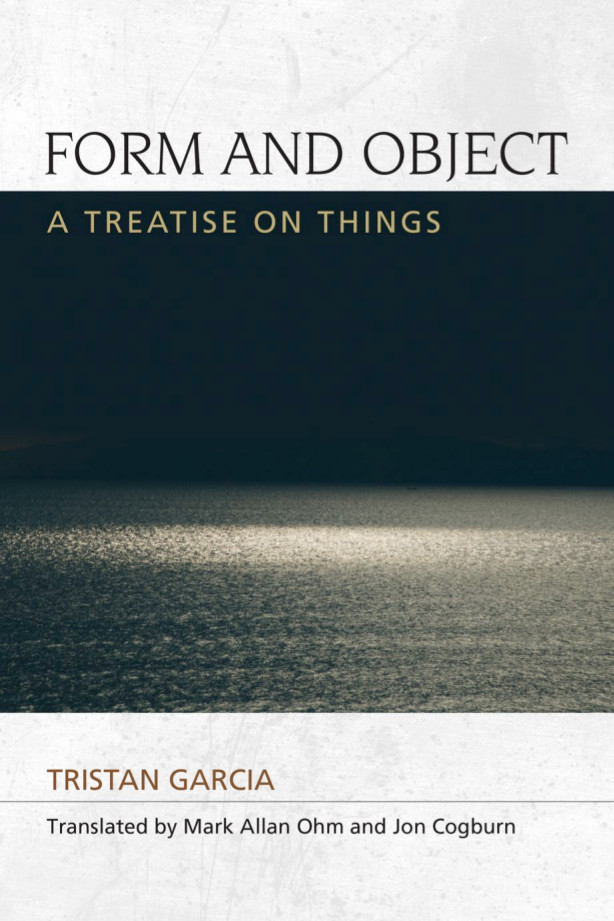Tristan Garcia: Form and Object: A Treatise on Things (2011–)
Filed under book | Tags: · animal, art, being, body, culture, economy, event, evolution, form, gender, human, knowledge, life, metaphysics, nature, nothing, object, ontology, philosophy, relation, representation, self, thing, time, value

“What is a thing? What is an object? Tristan Garcia aims to overturn 100 years of Heideggerian orthodoxy about the supposedly derivative nature of objects to put forward a new theory of ontology that gives us new insights into the world and our place in it.
Garcia’s original and systematic formal ontology of things strips them of any determination, intensity or depth. From this radical ontological poverty, he develops encyclopaedic regional ontologies of objects. By covering topics as diverse as the universe, events, time, the living, animals, human beings, representation, arts and rules, culture, history, political economy, values, classes, genders, ages of life and death, he shows that speculative metaphysics and ontology are alive and well.”
First published as Forme et objet. Un traité des choses, PUF, Paris, 2011.
Translated by Jon Cogburn and Mark Allan Ohm
Publisher Edinburgh University Press, 2014
ISBN 0748681493, 9780748681495
462 pages
On Graham Harman’s System and My Own by Garcia (2013), Harman’s response.
Interviews with Garcia: by Liam Jones (Figure/Ground, 2014), Philosophical Readings (2014).
Reviews and commentaries: Jean-Clet Martin (2012, FR, ES), Harman (Continent, 2012), Nathan Brown (Radical Philosophy, 2014).
Wikipedia (FR)
Publisher
WorldCat
PDF, PDF (updated on 2018-5-8)
Comment (0)Yve Alain Bois, Rosalind E. Krauss: Formless: A User’s Guide (1996/1997)
Filed under book | Tags: · aesthetics, art, art criticism, art history, entropy, form, kitsch, painting, photography

“In a work that will become indispensable to anyone seriously interested in modern art, Yve-Alain Bois and Rosalind Krauss convincingly introduce a new constellation of concepts to our understanding of avant-garde and modernist art practices. Formless constitutes a decisive and dramatic transformation of the study of twentieth-century culture. Although it has been over sixty years since Georges Bataille undertook his philosophical development of the term informe, only in recent years has the idea of the “formless” been deployed in theorizing and reconfiguring the very field of twentieth-century art. This is partly because that field has most often been crudely set up as a battle between form and content, whereas “formless” constitutes a third term that stands outside the opposition of form and content, outside the binary thinking that is itself formal.
In Formless, Bois and Krauss, two of the most influential and respected art historians of our time, present a rich and compelling panorama of the formless. They map out its persistence within a history of modernism that has always repressed it in the interest of privileging formal mastery, and they assess its destiny within current artistic production. In the domain of practice, they analyze it as an operational tool, the structural cunning of which has repeatedly been suppressed in the service of a thematics of art. Neither theme nor form, formless is, as Bataille himself expressed it, a “job.” The job of Formless is to explore the power of the informe. A stunning new map of twentieth-century art emerges from this innovative reconceptualization and from the brilliantly original analyses of the work of Jackson Pollock, Andy Warhol, Cy Twombly, Lucio Fontana, Cindy Sherman, Claes Oldenburg, Jean Dubuffet, Robert Smithson, and Gordon Matta-Clark, among others.”
First published as L’Informe: mode d’emploi, Centre Georges Pompidou, Paris, 1996.
Publisher Zone Books, 1997
ISBN 0942299434, 9780942299434
304 pages
PDF (updated on 2013-1-15)
Comments (3)
